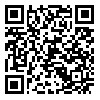BibTeX | RIS | EndNote | Medlars | ProCite | Reference Manager | RefWorks
Send citation to:
URL: http://rehabilitationj.uswr.ac.ir/article-1-3-en.html
Objective: Despite numerous advances in our understanding of the anatomy, Biomechanics, nutrition and Healing, the result Following Fiewor Tendon repair Shiow relatively high rate of failure the purpost of this study was to compare the result of 50 digits treated by either ‘‘Early active mobilization’’ or ‘‘controlled passive mobilization’’ re gimen in Ivan hand rehabilitation center.
Materials & Mathods: Pationt being matched for gende, age, injuries hand, technique of srgery (all with eqitenon first, four strand) in two groups. They were assessed 8 week postoperatibg in respect of total active motion, flexion gap and extension lags. Outcome were defined using ‘‘Strickland’’ and ‘’ Buck – Gramko’’ criteria.
Results: The result were 80% excellent and good, 20% fair and no poor in early active motion group and in second group 40% excellent and good, 44% fair and 16% poor due to Strickland criteria. In buck-grancko criteria 52% extension and good, 32% fair and 16% were poor. Mean of total active motion was significantly greater in early active motion group (in E.A.M.150/2, in passive group: 116/41).
Conclusion: Actively mobilized tendon underwent intrinsic healing without large gap formation. Active motion generated bith tension and motion and offer several advantage over passive motion: improved tendon nutrition, less adhission, higher rate of healing, increased ultimate rang of motion. So early active motion is the best protocle for treating tendons in zons 2 our result is comparable with theory.
Received: 18/07/2007 | Accepted: 7/10/2015 | Published: 7/10/2015
| Rights and permissions | |
 |
This work is licensed under a Creative Commons Attribution-NonCommercial 4.0 International License. |





